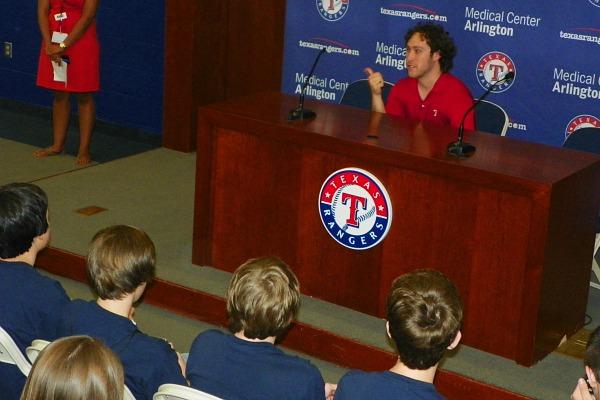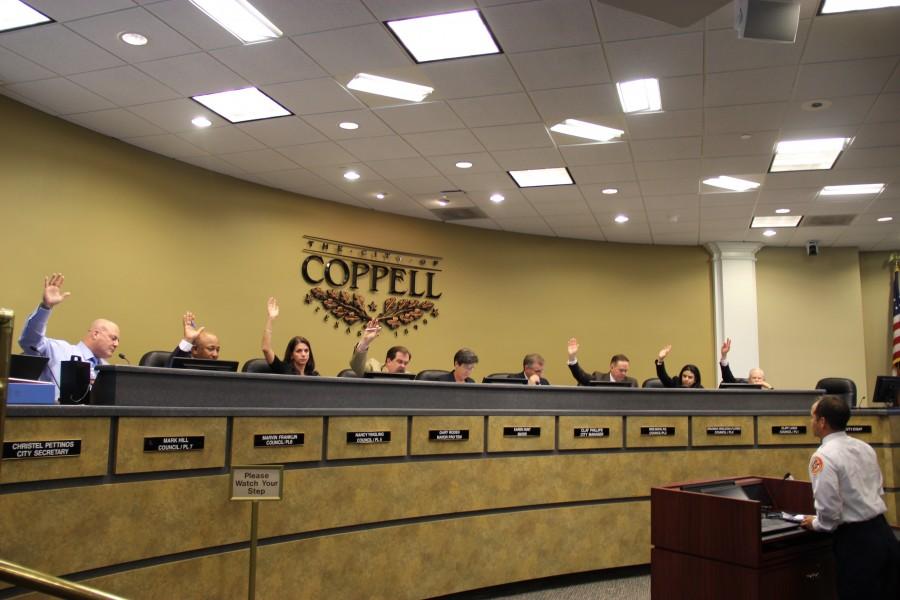Media world sets high goal to reach for
By Jordan Bickham
Staff Writer
With special press boxes with a great view and their own private offices to report from, the media behind sports are allowed many benefits in order to bring the most current information to their audiences. But these media benefits are not given to just anyone, they have had to go through plenty of hard work to get that far.
As the Emerging Media and Communications (EMAC) Academy went on a tour of the Rangers Ballpark in Arlington on Thursday, it got to experience what it would be like to be a TV announcer or a radio host for a Rangers game. Thirty-six students and four teachers also heard from those who worked within communications for the stadium and understood that it takes a lot to make it in the media world.
“I was involved in the video technology part of it [journalism],” Rangers digital media and marketing content producer Alan Rose said. “My sophomore year [at Highland Park High School] I did video tech, then my junior year I was in charge of our monthly news broadcast as an officer, and then senior year I was in charge of all the programs.”
Rose has been working for the stadium for two years, but even before that, he was given the chance to be an intern. But an intern for the Texas Rangers is a pretty incredible opportunity, and he would have never gotten it if he had not taken chances in high school.
“I went to Highland Park and graduated in 2006, and there was a pitcher named Chris Young who pitches for the Mets right now,” Rose said. “He graduated from Highland Park in 1998, so my junior year of high school, I was doing the video tech department stuff and I did a documentary on his major league debut. So I actually contacted the Rangers…and was able to set up an interview in this room with Chris Young. I kept in contact and a few years later, I was able to get an internship.”
This documentary led him to SMU and work more in communications and it allowed him to get an internship with the Rangers with eventually led to his current position. But getting there was not easy, Rose had to put himself out there in order to get everything he needed for his documentary and even today he says that those interested in communications should never be shy.
“Definitely don’t be shy and be ready to start at the bottom,” Rose said, as advice to the students looking into the same career path as him.
From this field trip, not only did EMAC academy students get a behind the scenes look at the media that goes into a great Rangers game, but they also were able to figure out what they needed to do and know in order to get their dream career.
Media becomes more hectic after World Series
By Kristen Shepard
Staff Writer
After nearly 40 years of mediocrity, the Texas Rangers emerged on the national scene by advancing to the past two World Series. And with the success of the team came an increase in media attention
“When the team entered the playoffs, the MLB comes in an basically takes over all media operations, they own the copyright for the playoffs and literally come in and do things differently,” Rangers communications coordinator Amber Sims said. “Things definitely get more hectic during playoffs, and we have to make a lot of accommodations.”
For one, the expansive Ranger Ballpark press facilities simply could not hold all of the reporters and broadcasters covering the games. In response, many members of the media were required to work in auxiliary areas adjacent to the permanent press box.
Aside from television and print journalism, radio broadcasts increased especially after the World Series. The teams’ official radio station ESPN Radio saw a huge increase in its audience and interest after the first World Series.
“One day, we received a call from a man in Tennessee saying that he could not watch the Rangers because he did not have Channel 21,” Sims said. “We recommended a radio station to him. So many people across the United States tune into sports radio and as the fan base for the Rangers has grown, so has radio popularity.”
Stakes for the in-stadium media are higher during the World Series as well, with even playing music at the wrong time can lead to angered players and umpires. Rules for music and banners are so specific that flashing lights can not be present anywhere in the stadium as the pitcher throws the ball.
Every part of media for the Rangers experienced an increase in popularity following the recent postseason success. For Highland Park and SMU graduate, Allen Rose, his career in convergence journalism for the Rangers shifted as media popularity skyrocketed. Rose is the Rangers’ lead multimedia content producer.
“I helped with the changes in texasrangers.com we made video promos and everything we did got more views” Rose said. “We wanted to make sure that everything we put out there was our best quality and was current and exciting”.
Public Relations proves crucial in MLB
By Christina Burke
Staff Writer
Although the majority of the Texas Rangers’ success in the past couple of years has been achieved through hard work, sweat and dedication, they are also fortunate enough to have the public in their favor. They owe this portion of their success to their committed media department.
In the Emerging Media and Communications (EMAC) Academy at Coppell High School, the students are being trained for a productive and prosperous career in communications. On March 29, they traveled to Rangers Ballpark in Arlington in order to gain behind the scenes experience about what goes on in sports media.
The students met up with their tour guide, Amber Sims, who works as communications coordinator for the Texas Rangers. Sims explained the importance of her job in Public Relations, and what she does to help the Rangers thrive as a team in Major League Baseball.
“Some of the highlights of my job are, from a Public Relations standpoint, getting to be behind the scenes. You always know what it going on before it happens,” Sims said. “The thing about Public Relations is that everyone has to use it and everyone needs it. What I love about public relations is that it involves everything. It is basically telling the story of the organization.”
Sims encouraged the EMAC students to broaden their horizons of interests in communications. She also studied many types of media while in school and ended up perusing Public Relations with aspirations to be a network producer.
“It is interesting to be on the other side of the news. I would encourage you to think about communications from all perspectives, not just being in front of or behind a camera, but also the side of Public Relations,” Sims said.
It is crucial, in sports media, for teams to have a secure Public Relations team behind their back for the best of times and the worst of times. The Texas Rangers’ Public Relations team has been behind them one hundred percent through events such as the World Series promotions and also troubles such as Josh Hamilton’s relapse.
The Public Relations department is necessary for controlling controversy that the team may face, and everything that the public knows about it. With incidents such as the death of a fan in the last season, Public Relations are responsible for presenting statements, press releases and press conferences to the public expressing the team’s great compassion towards the situation. The key to a positive group image lies in their hands.
Meet the Press: Rangers Style
By John Loop
Staff Writer
The podium at the Ballpark in Arlington. Home to manager Ron Washington’s famous “That’s the way baseball go” comment. So many memories remain in this room and many others in use by the media and staff at the stadium of the two-time American League champion Texas Rangers.
Members of the EMAC Academy traveled to the ball yard on Thursday to explore the sights and sounds of the stadium through a media member’s eye’s and ears. The tour was led by Amber Sims, a Communications Coordinator.
The tour began in the press box, where Sims showed students the ins and outs of the media booth directly behind home plate.
“As many as 100 people can fit in here at a time,” Sims said. “But, as you can imagine, during the past two years of World Series’, we’ve had to cram 200 plus reporters into this room.”
Sims also mentioned that, in order to accommodate the frenetic reporters, they set up an auxiliary press area on the terrace below.
After seeing the press box, students ventured into the radio broadcast booths for the metroplex and Spanish affiliates.
“We have 23 radio affiliates all over the nation,” Sims said. “That’s not even close to the Atlanta Braves, who lead the league with over one hundred. Hopefully we’ll get up closer to the top in the coming years.”
The tour then stepped into the control room of the new video board, sitting atop the Home Run Porch in straightaway right field. There the group met Chuck Morgan, Executive Vice President of Ballpark Entertainment & Productions, who also serves as the stadium’s public address announcer.
Morgan explained that matters in the video board sometimes get a little brisk in the booth during games because of the MLB regulations.
“The [MLB] tells us, me specifically, that I have to introduce the batter at the 1:40 mark of a two-minute break,” Morgan said. “There are other strict guidelines too. Everything, music, the ribbon boards, the big board, it all stops after the batter steps into the box.”
It may seem like an easy job, but Morgan says that when you make a mistake, it is not so easy to cover.
“In the age that we live in today, if you make a mistake, its around the world in under two minutes,” Morgan said. “That’s why we have a big red button to hit when something isn’t right.”
The Rangers organization was one of the first in baseball to utilize a video board since they were invented in the early eighties.
Towards the end of the tour, the group was ushered into the interview room, where lead videographer, Highland Park and SMU graduate Alan Rose, talked to the students about the importance of the things said in this room.
“Pretty much after every game, Ron Washington comes in here and talks about the game,” Rose said. “The things that area said in this room are very important to the reporters and the team at the same time.”
All in all, the media facilities at the Ballpark are top quality, a reflection on the department who helps keep them going.











